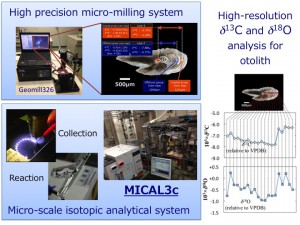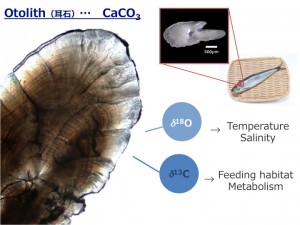Toyoho Ishimura
Development of the ultra-high resolution stable isotopic analytical technique to clarify the life history recorded in fish otolith
Research Summary
While many studies have investigated the correlation of ocean dynamics and ocean productivities, the limited number of studies have addressed fish abundance in relation to the ocean mixing process at the Northwest Pacific Ocean. The study of such correlations would contribute to understand fish stock structures and migration patterns of a fish in the North West Pacific Ocean. Acquiring these information would have tremendous importance for fishery management and fish conservation.
The fish otolith grows proportionally as fish growth by adding a growth ring. As the fish grows, with daily or annually time interval, a new growth ring of the fish otolith is added by accumulating calcium carbonate (CaCO3). The stable oxygen isotope (δ18O) in each ring suggests the marine environment (water temperature, salinity) which fish inhabit at that time. Thus, with spatial and temporal ocean observation data, this enables us to understand the detailed migration patterns of fish.
It requires realizing “high-precision and high-resolution” isotopic analysis in simultaneously to understand spatial and temporal fish migration patterns available for fish management. Such techniques and methods, however, have not been developed until recently.
This study intends to develop the stable oxygen isotope (δ18O) analytical method to realize the high-precision microscale analysis for a growth ring of fish otolith by using the microscale isotopic analytical system (MICAL3c). Then, this study will apply the analytical technique to fish otolith in the Northwest Pacific Ocean, to discuss the correlation of the spatial and temporal fish migrations in relation to the ocean mixing processes.
Principal Investigator:
Toyoho Ishimura
National Institute of Technology, Ibaraki College, Associate Professor, Stable Isotope Geochemistry, Micropaleontology
http://toyoho.jimdo.com




